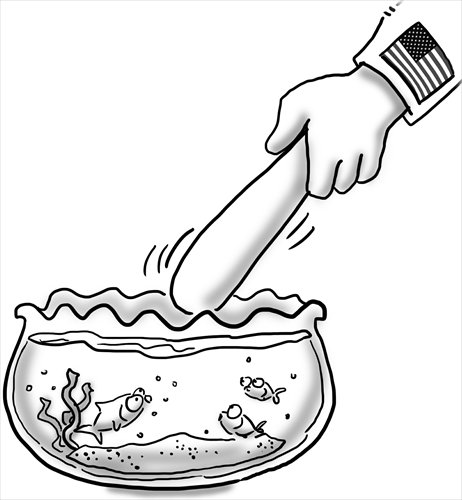US ready to reposition in South China Sea

Illustration: Shen Lan/GT
US Navy destroyer USS Curtis Wilbur sailed within 12 nautical miles of China's Zhongjian Island in the Xisha Islands on January 30. This intervention triggered a new round of engagement between China and the US over the South China Sea disputes. This is more threatening than USS Lassen's October intrusion in the South China Sea, because this time, a US navy warship moved much closer to the Chinese mainland and the territorial sea baseline of Xisha Islands was announced by China long before.
The US sending a warship into Chinese territorial waters without approval could be regarded as a threat to China's sovereignty and national security and a challenge to China's claims in the South China Sea disputes. As Cui Tiankai, the Chinese ambassador to the US, said, the US actions were "a very serious provocation, politically and militarily."
US President Barack Obama is in the last year of his second term of office. But he has ramped up maneuvering the South China Sea disputes.
Secretary of State John Kerry visited two Southeast Asian nations, Laos and Cambodia, in January, and Harry Harris, head of the US Pacific Command, made an absurd comment that the South China Sea islands "do not belong to China."
In addition, US Defense Secretary Ash Carter said the military budget request for the fiscal year 2017 "responds to Chinese military modernization."
All these moves have demonstrated that the South China Sea will remain an important handle for the US to implement its "rebalance to Asia" strategy. The Sino-US relationship will meet graver challenges in 2016.
The US-ASEAN Summit heralds another important opportunity for the Obama administration to reinforce his South China Sea strategy. Since the decision to host this summit was announced in December, the US has kept underlining the significance of the meeting.
The summit is being held at Sunnylands, California, where Obama met with Chinese President Xi Jinping in 2013. This choice of place shows that the Obama administration gives high emphasis on the US-ASEAN relationship and the US commitment to Southeast Asia.
In the past seven years, Obama has visited Southeast Asia seven times, and greatly promoted the implementation of his strategy. This is the first time that a US-ASEAN summit is held beyond the region, which displays the US' determination and capability of dominating regional agenda.
Unlike before when the US usually remained behind the scenes to influence the development of the South China Sea issues, it has become more active in backing the Philippines and Vietnam to counter China, and it is paying more attention to realize its purposes through regional mechanisms. Washington is shifting its South China Sea policy, and the US-ASEAN Summit is the latest proof.
In the two-day meeting, Obama and 10 ASEAN leaders will engage in discussions about a wide range of topics, but the key topics are the Trans-Pacific Partnership (TPP) and the South China Sea disputes.
Daniel Russel, the Assistant Secretary of State for East Asian and Pacific Affairs, specifically pointed out that the Summit "is not about China … is not anti-China. It's about the US and ASEAN."
This summit will be included in the all-out strategy of the US rebalance to the Asia-Pacific. Through communication in economic, political and military dimensions, Washington aims to find more common ground with ASEAN and deepen their cooperation, so that it can maintain competitive edges in Southeast Asia.
This narrative of "common ground," in the geopolitical circumstances of Southeast Asia, is just another piece of rhetoric used by the US to hide its intention of countering China.
The Obama administration is trying to promote TPP within ASEAN by the chance of the meeting for the purpose of consolidating its dominance in regional economic development. Washington doesn't want Beijing to be another rule-maker, but a follower.
Washington intends to find more strategic common ground with ASEAN over the South China Sea disputes. On the surface, Washington calls for international laws and norms, such as freedom of navigation, to be the guiding principle in the South China Sea. In fact, it tries to hype up China's "threat" to regional security and ASEAN's interests so more ASEAN members will join a US-led front to counter China.
But ASEAN does not always speak with one voice, so it is unknown whether Washington's goals can be realized in the summit. It could be anticipated that the US will spare no effort leading the process of agenda-making. But most ASEAN members are not willing to pick sides between China and the US.
The author is an assistant research fellow at the China Institute of International Studies. opinion@globaltimes.com.cn